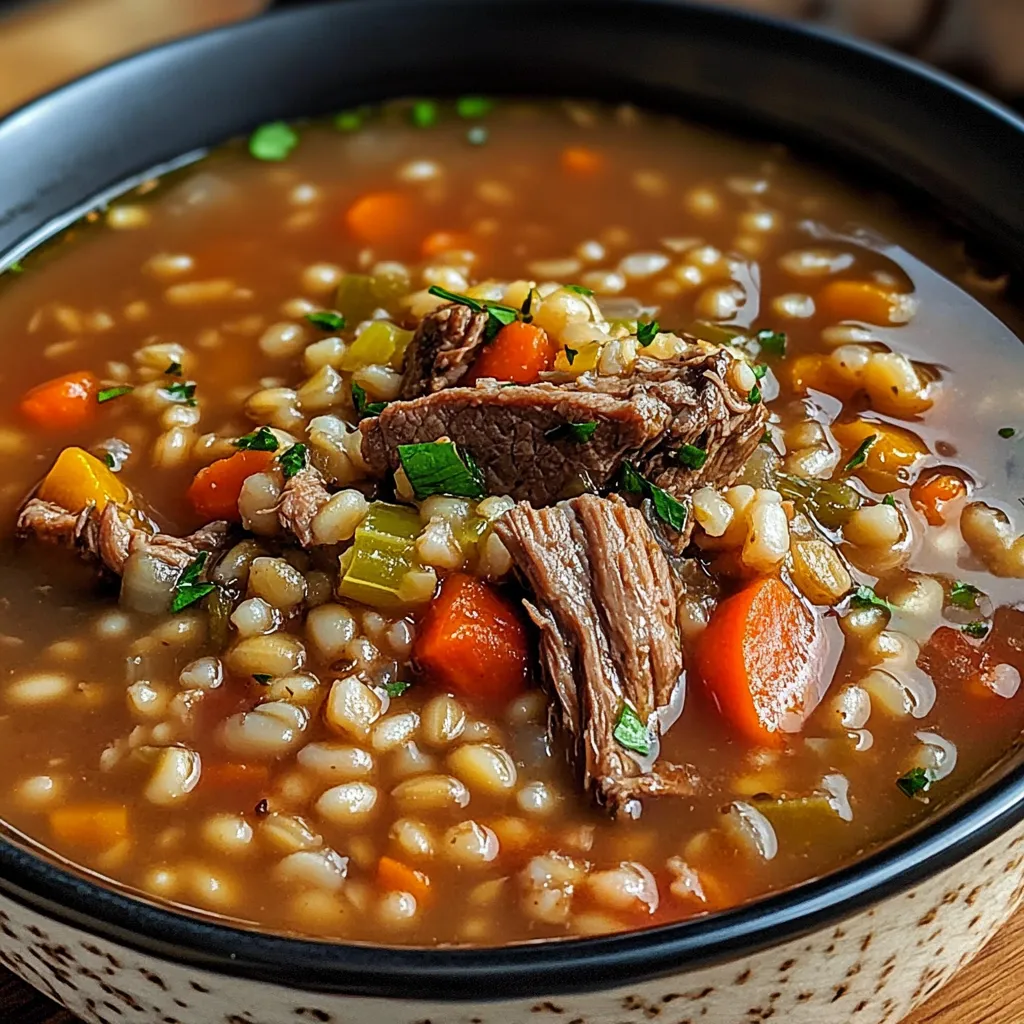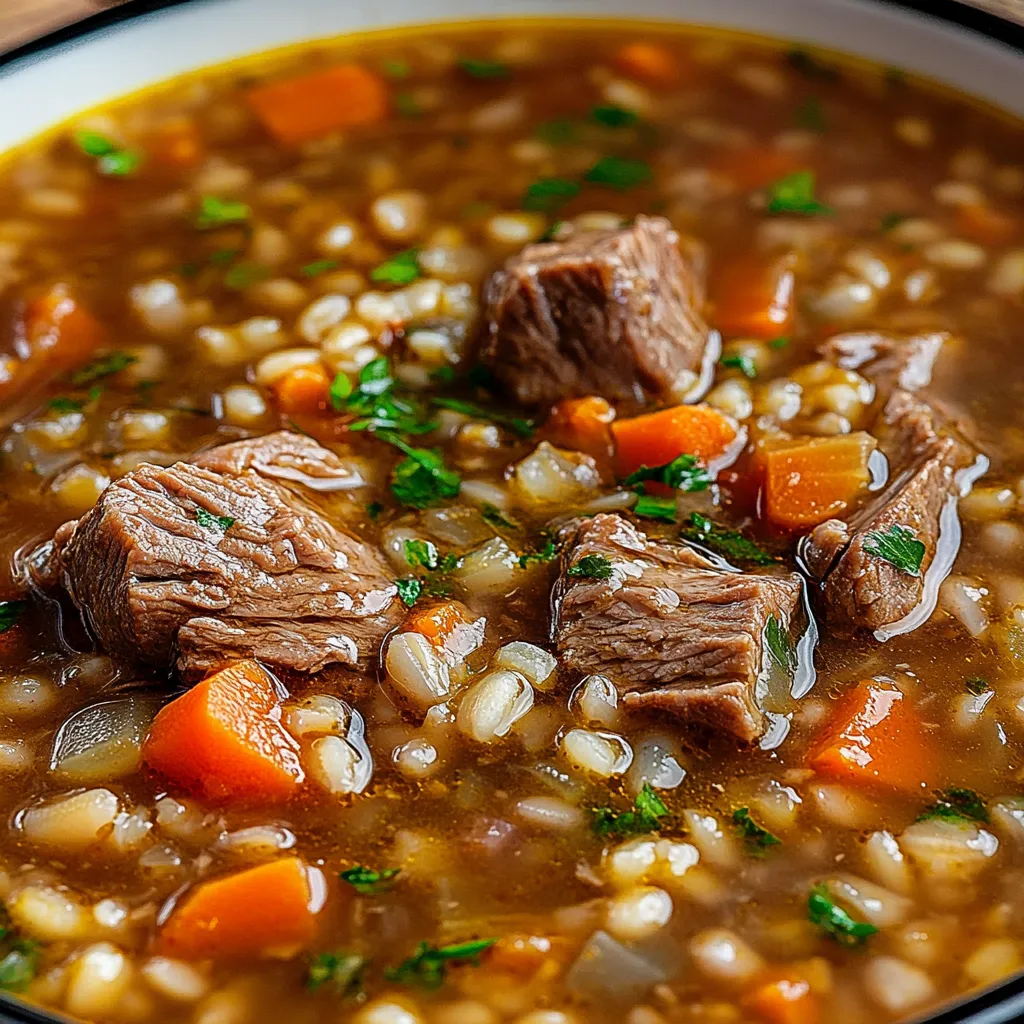Introduction to Beef and Barley Soup
Beef and Barley Soup is a classic dish with roots that trace back to ancient civilizations. Barley, one of the oldest cultivated grains, has been a staple in soups for centuries due to its high nutritional content and affordability. Combining it with beef has made this soup a hearty and satisfying meal enjoyed across various cultures. Over time, it has evolved into a beloved comfort food known for its rich flavor and wholesome ingredients.
This soup is especially popular during the colder months because it offers a perfect balance of tender beef, nutritious barley, and vegetables. The combination of ingredients provides a warm, satisfying dish that is both filling and nutritious. It’s no wonder that Beef and Barley Soup has become a go-to comfort meal for families worldwide.
Aside from its comforting qualities, this soup is packed with essential nutrients, making it an excellent option for those seeking a balanced, healthy meal. The fiber-rich barley supports digestion, while the protein from beef helps with muscle growth and repair. You can also explore the specific health benefits of barley and how it supports heart health and weight management. Additionally, selecting the right cut of beef is crucial to ensuring the dish’s richness—learn more about the best cuts of beef for soups to perfect this recipe.
Beef and Barley Soup is not only a flavorful meal but also a nutritional powerhouse, making it a popular choice for both health-conscious individuals and those simply looking for a cozy bowl of comfort food.
Step-by-Step Preparation

Preparing the Beef
When making Beef and Barley Soup, choosing the right cut of beef is essential for achieving a tender, flavorful dish. The best cuts for this soup are chuck roast, short ribs, or stew meat, as they become tender during slow cooking. These cuts are rich in connective tissues that break down and add depth to the broth.
To enhance the flavor of the beef, sear it first. Heat a small amount of oil in a pot and brown the beef on all sides. Searing creates a rich caramelized crust, locking in juices and adding complexity to the soup’s flavor.
Preparing the Vegetables
The most common vegetables used in Beef and Barley Soup are carrots, celery, and onions. These vegetables form the flavor base, giving the soup a sweet and aromatic depth. Start by chopping them into small, uniform pieces to ensure even cooking.
For the best flavor, sauté the vegetables in the same pot where you seared the beef. This technique allows you to deglaze the pot, lifting up the browned bits left from the beef, which enhances the soup’s richness. Cooking the vegetables until they are slightly softened will add layers of flavor and sweetness to your dish.
Cooking the Barley
Barley plays a key role in both the texture and nutrition of this soup. When cooking barley, it’s important to rinse it under cold water to remove excess starch, which can make the soup too thick. For the best texture, use pearl barley, which cooks faster, or hulled barley, which retains more nutrients but requires longer cooking.
Barley absorbs a lot of liquid, making the soup thicker over time. You can adjust the consistency by adding more broth as needed. Learn more about the proper ways to cook barley to get the perfect texture in your soup.
Combining Ingredients
Once your beef and vegetables are ready, it’s time to combine all the ingredients. Add the seared beef, sautéed vegetables, and rinsed barley back into the pot. Pour in the beef broth or stock, ensuring everything is well-covered by the liquid.
Bring the soup to a boil, then reduce the heat and let it simmer for about 60–90 minutes. This low, slow cooking process allows the flavors to meld together and the beef to become tender. Be sure to occasionally check the liquid level, adding more broth if necessary, to prevent the soup from becoming too thick.
Final Touches
Once the soup is fully cooked, it’s time to add the final seasonings. Taste the broth and adjust with salt, pepper, and herbs like thyme or bay leaves. For a richer flavor, consider adding a splash of Worcestershire sauce or a dash of paprika.
For garnishing, sprinkle freshly chopped parsley or add a bit of grated cheese on top for extra richness. These final touches will elevate your soup, giving it a burst of freshness and a hint of creamy indulgence that perfectly complements the hearty flavors of the dish.
Variations and Customizations

Vegetarian/Vegan Variations
If you’re looking for a plant-based alternative to traditional Beef and Barley Soup, it’s easy to make a vegetarian or vegan version without sacrificing flavor. Instead of beef, replace it with hearty mushrooms like portobello or cremini, which provide a meaty texture and umami flavor. You can also add tofu for extra protein. To enhance the flavor, sauté the mushrooms or tofu in the same way you would with beef, searing them to create a rich base. For a fully vegan option, ensure that you use vegetable broth instead of beef broth to keep it plant-based.
Slow Cooker/Crockpot Version
Making Beef and Barley Soup in a slow cooker is a fantastic way to simplify the process and still achieve rich, flavorful results. To adapt the recipe, first brown the beef (or mushrooms for a vegan option) and sauté the vegetables on the stovetop, as searing enhances flavor. Then transfer everything to the slow cooker, adding the barley and broth. Cook on low for 6–8 hours or on high for 3–4 hours. The long, slow cooking ensures that the beef becomes incredibly tender, and the barley perfectly absorbs the flavors of the broth.
Regional Variations
Beef and Barley Soup has many variations across different regions. In the Mediterranean, you might find the soup flavored with rosemary, oregano, and even a touch of lemon for brightness. In Asian-inspired versions, soy sauce, ginger, and bok choy may replace traditional ingredients for a savory, umami-rich twist. In colder regions, the soup might include root vegetables like turnips or parsnips to add extra heartiness. These regional adaptations demonstrate the versatility of the soup, allowing you to tweak it to fit your preferences and local flavors.
Cooking Tips for Perfect Beef Barley Soup
How to Avoid Overcooking the Barley
Barley can easily become mushy if overcooked, which can affect the texture of your soup. To avoid this, add the barley toward the middle of the cooking process, especially if you’re simmering the soup for a long time. Another option is to cook the barley separately and add it to the soup just before serving. This way, you can control the texture more easily, keeping it chewy and firm rather than mushy. If using a slow cooker, consider using pearl barley, which holds up better during long cooking times.
Best Practices for Making the Soup Ahead of Time
Beef and Barley Soup is a great dish to make ahead because the flavors deepen over time. However, barley continues to absorb liquid as it sits, which can make the soup thicker. To prevent this, cook the barley separately and store it separately from the soup. When you’re ready to serve, combine the barley and soup, adjusting the consistency with additional broth if necessary. This method ensures that both the beef and barley retain their ideal texture.
Storing and Reheating Tips
For best flavor retention, store the soup in airtight containers in the refrigerator for up to 3–4 days. When reheating, do so slowly over low heat to prevent overcooking. If the soup has thickened, you can add a bit of broth or water to restore its consistency. For freezing, keep the barley separate to avoid it becoming too soft when thawed and reheated.
Nutritional Breakdown

Beef and Barley Soup is not only comforting but also highly nutritious, making it an excellent choice for a balanced diet. A typical serving of beef and barley soup contains around 300-400 calories, depending on the portion size and specific ingredients used. It’s rich in protein, with about 20-25 grams per serving, thanks to the inclusion of beef, which is essential for muscle repair and growth. Additionally, this soup provides a good amount of fiber, with about 5-8 grams coming from the barley, which aids in digestion and helps you feel fuller for longer.
Barley is particularly beneficial for heart health due to its high beta-glucan content, a type of soluble fiber that helps lower cholesterol levels. It also supports healthy digestion by feeding beneficial gut bacteria and promoting regular bowel movements. Barley’s low glycemic index makes it a great option for those looking to control blood sugar levels, contributing to a well-rounded, healthy diet. To learn more about the nutritional benefits of barley, check out this comprehensive guide.
This soup is the perfect combination of protein, fiber, and essential vitamins from the beef and vegetables, making it a great option for maintaining energy and supporting overall health.
Health Benefits of Key Ingredients
Beef
Beef is an excellent source of iron, crucial for preventing anemia and maintaining energy levels. It’s also rich in protein, which supports muscle health, tissue repair, and immune function.
Vegetables
The carrots, celery, and onions in this soup provide a host of vitamins and minerals, such as vitamin A for eye health and vitamin C for immune support. These vegetables also add fiber, which is vital for digestive health and preventing chronic diseases.
FAQs
Can I Freeze Beef and Barley Soup?
Yes, you can freeze Beef and Barley Soup, but it’s best to freeze it without the barley to avoid it becoming mushy when thawed and reheated. If you’ve already added the barley, freeze the soup in individual portions for easier reheating. When you’re ready to enjoy it, thaw the soup overnight in the refrigerator and reheat it on the stove over low heat. If the soup has thickened, add a little broth or water to restore its original consistency. For more tips on freezing, check out these best freezing practices.
What Are the Best Cuts of Beef for This Soup?
The best cuts of beef for Beef and Barley Soup are ones that become tender during slow cooking. Chuck roast, stew meat, and short ribs are excellent choices because they have a good amount of connective tissue that breaks down, adding richness to the broth. These cuts are perfect for simmering over low heat for an extended period, resulting in a melt-in-your-mouth texture.
Can I Use Instant Barley?
Yes, you can use instant barley if you’re short on time. Instant barley cooks much faster, but it may not have the same chewy texture as traditional barley. If you prefer a heartier bite, opt for pearl barley, which takes longer to cook but holds up better in soups. Keep in mind that traditional barley also absorbs more flavors from the broth.
How Can I Make It Gluten-Free?
To make Beef and Barley Soup gluten-free, you can replace the barley with gluten-free grains like quinoa, brown rice, or millet. These grains will give the soup a similar texture while keeping it suitable for those with gluten sensitivities. Make sure to use gluten-free broth as well.
Conclusion and External Resources
Final Thoughts
Beef and Barley Soup is a versatile and comforting dish that can be easily customized to suit your preferences. Whether you’re opting for a hearty beef version or a vegetarian twist with mushrooms and tofu, this soup offers endless possibilities. Its combination of rich flavors and nutritional benefits—from protein-packed beef to fiber-rich barley—makes it a perfect choice for any meal. You can try regional variations or use a slow cooker for added convenience. For more ideas on customizing your recipe, explore different regional variations and cooking tips for barley to create your ideal bowl of comfort.
